Abstract
In this study, we examined the potential interactions between antimalarial (chloroquine, quinine, and mefloquine) and oxidant reagents. The data indicate that their effects enhance those of one another in vitro. The viability of Plasmodium falciparum in culture was assessed by [3H]hypoxanthine incorporation during 24 h of incubation in the presence of lactoperoxidase, glucose-glucose oxidase, hydrogen peroxide, chloroquine, quinine, and mefloquine, either alone or in combination. At subinhibitory concentrations, a significant inhibition was produced by the following combinations: lactoperoxidase plus hydrogen peroxide, lactoperoxidase plus glucose-glucose oxidase, lactoperoxidase plus hydrogen peroxide or glucose-glucose oxidase plus chloroquine or quinine but not with mefloquine. Deletion of any component from the system markedly decreased the toxic effect on P. falciparum. This toxic effect was not inhibited by catalase. These results indicate that the peroxidase-hydrogen peroxide system and antimalarial drugs can potentiate each other to inhibit the growth of P. falciparum.
Full text
PDF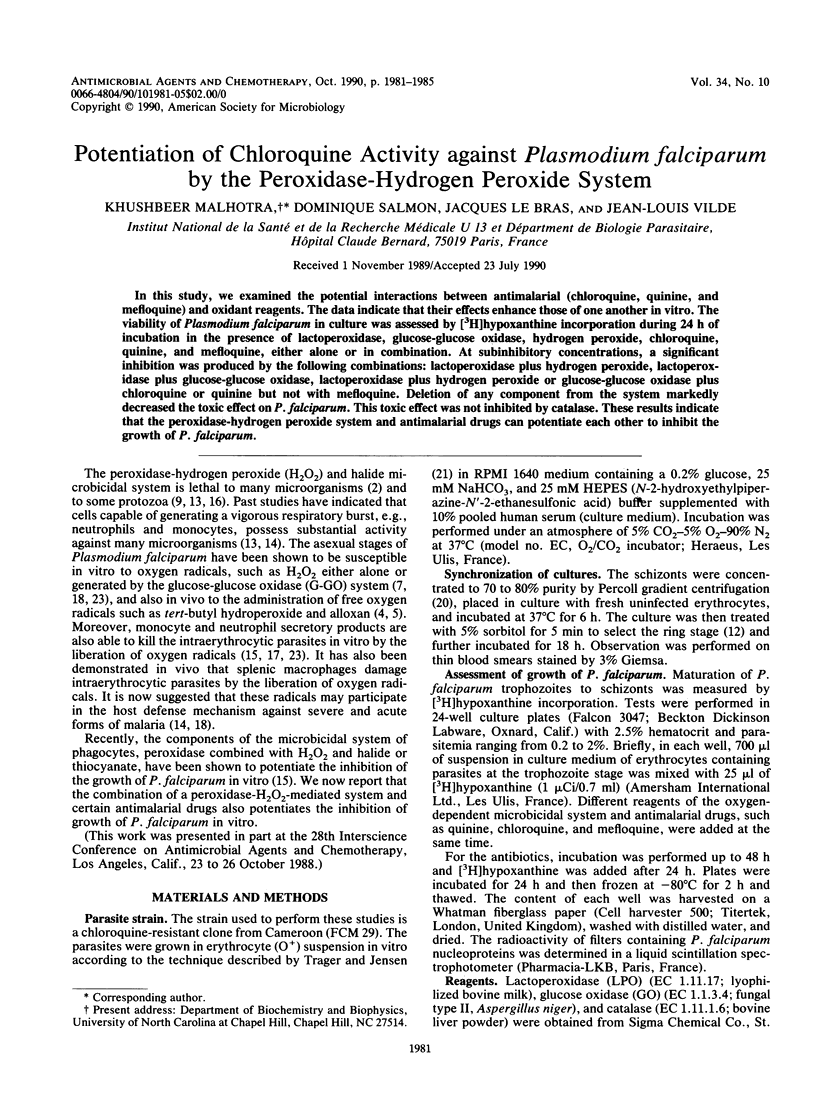
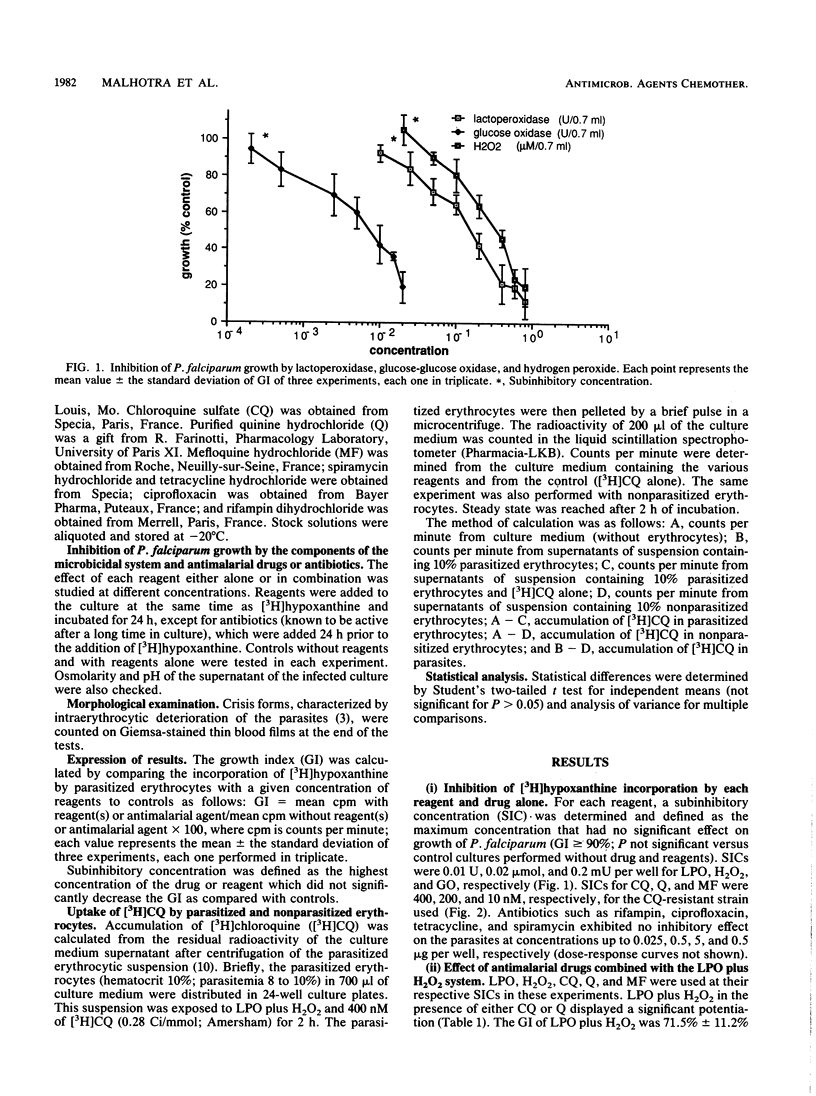
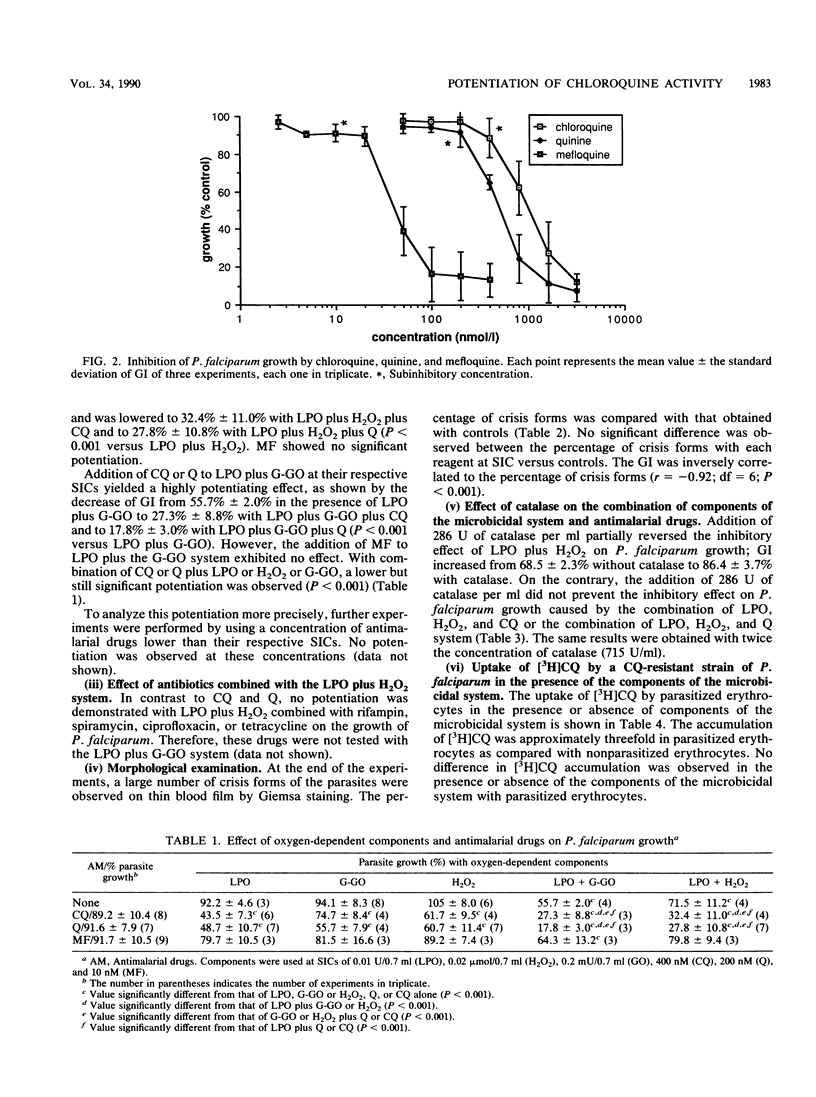
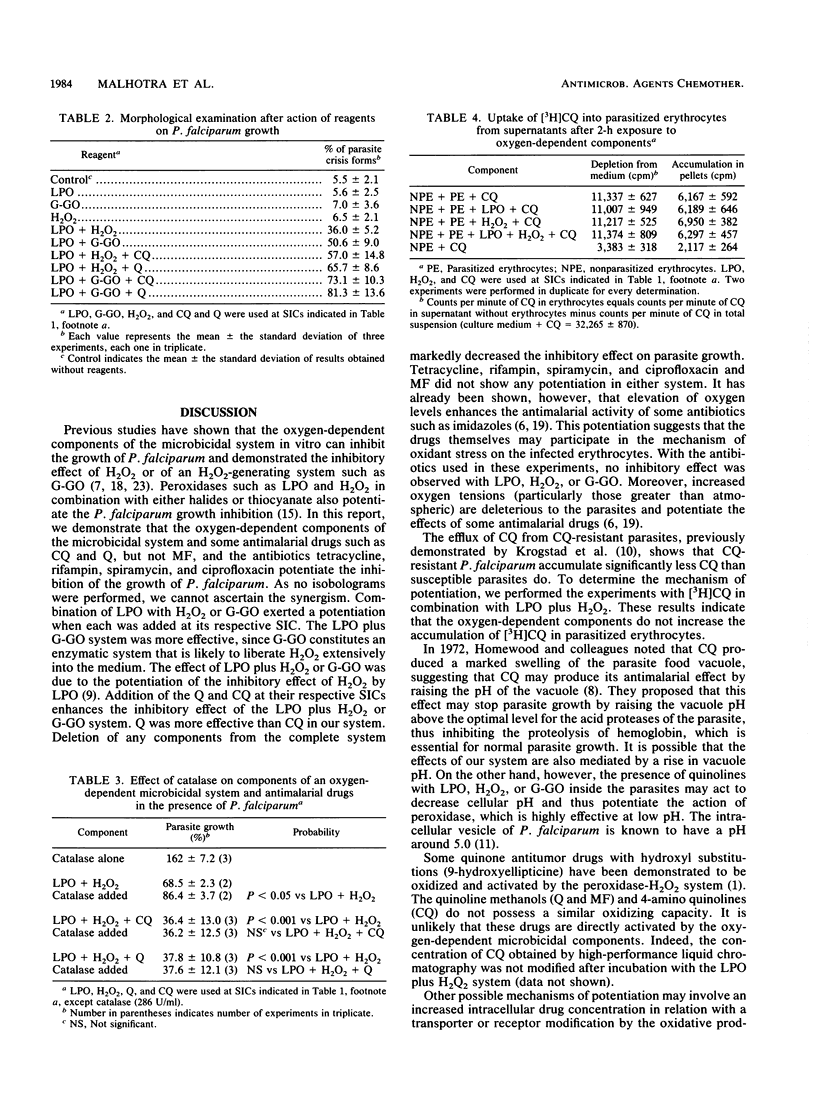
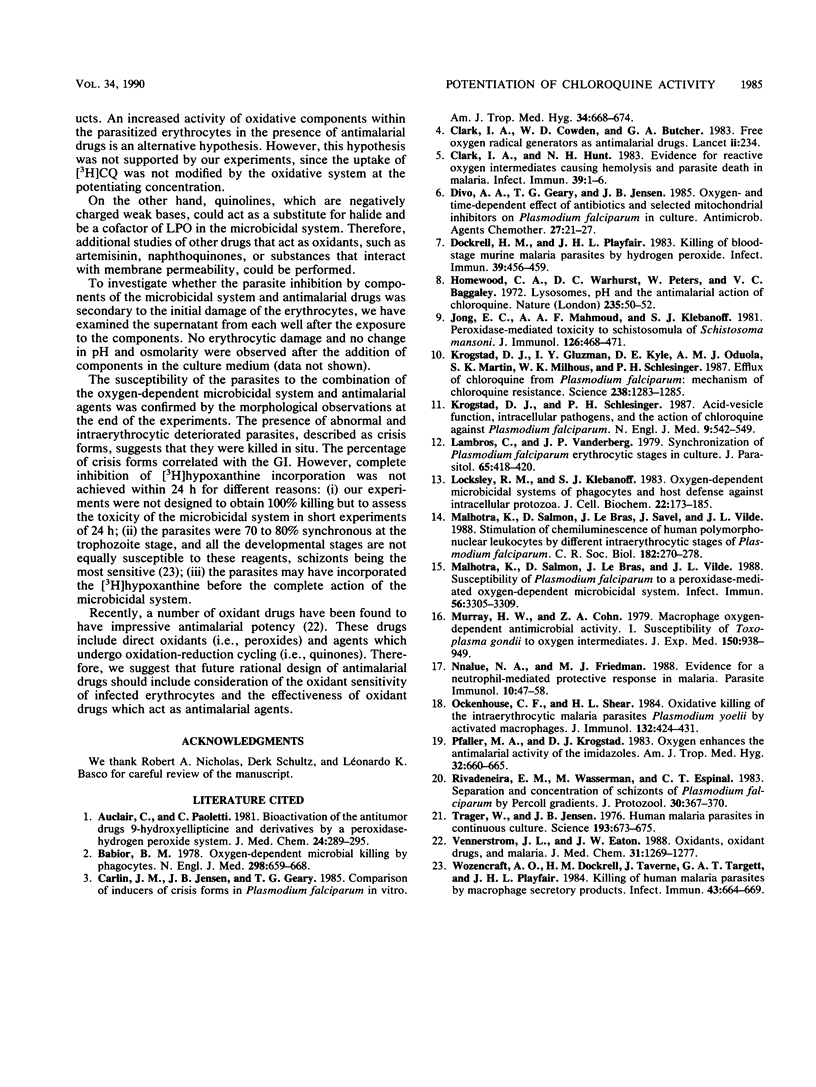
Selected References
These references are in PubMed. This may not be the complete list of references from this article.
- Auclair C., Paoletti C. Bioactivation of the antitumor drugs 9-hydroxyellipticine and derivatives by a peroxidase-hydrogen peroxide system. J Med Chem. 1981 Mar;24(3):289–295. doi: 10.1021/jm00135a010. [DOI] [PubMed] [Google Scholar]
- Babior B. M. Oxygen-dependent microbial killing by phagocytes (first of two parts). N Engl J Med. 1978 Mar 23;298(12):659–668. doi: 10.1056/NEJM197803232981205. [DOI] [PubMed] [Google Scholar]
- Carlin J. M., Jensen J. B., Geary T. G. Comparison of inducers of crisis forms in Plasmodium falciparum in vitro. Am J Trop Med Hyg. 1985 Jul;34(4):668–674. doi: 10.4269/ajtmh.1985.34.668. [DOI] [PubMed] [Google Scholar]
- Clark I. A., Cowden W. B., Butcher G. A. Free oxygen radical generators as antimalarial drugs. Lancet. 1983 Jan 29;1(8318):234–234. doi: 10.1016/s0140-6736(83)92603-x. [DOI] [PubMed] [Google Scholar]
- Clark I. A., Hunt N. H. Evidence for reactive oxygen intermediates causing hemolysis and parasite death in malaria. Infect Immun. 1983 Jan;39(1):1–6. doi: 10.1128/iai.39.1.1-6.1983. [DOI] [PMC free article] [PubMed] [Google Scholar]
- Divo A. A., Geary T. G., Jensen J. B. Oxygen- and time-dependent effects of antibiotics and selected mitochondrial inhibitors on Plasmodium falciparum in culture. Antimicrob Agents Chemother. 1985 Jan;27(1):21–27. doi: 10.1128/aac.27.1.21. [DOI] [PMC free article] [PubMed] [Google Scholar]
- Dockrell H. M., Playfair J. H. Killing of blood-stage murine malaria parasites by hydrogen peroxide. Infect Immun. 1983 Jan;39(1):456–459. doi: 10.1128/iai.39.1.456-459.1983. [DOI] [PMC free article] [PubMed] [Google Scholar]
- Homewood C. A., Warhurst D. C., Peters W., Baggaley V. C. Lysosomes, pH and the anti-malarial action of chloroquine. Nature. 1972 Jan 7;235(5332):50–52. doi: 10.1038/235050a0. [DOI] [PubMed] [Google Scholar]
- Jong E. C., Mahmoud A. A., Klebanoff S. J. Peroxidase-mediated toxicity to schistosomula of Schistosoma mansoni. J Immunol. 1981 Feb;126(2):468–471. [PubMed] [Google Scholar]
- Krogstad D. J., Gluzman I. Y., Kyle D. E., Oduola A. M., Martin S. K., Milhous W. K., Schlesinger P. H. Efflux of chloroquine from Plasmodium falciparum: mechanism of chloroquine resistance. Science. 1987 Nov 27;238(4831):1283–1285. doi: 10.1126/science.3317830. [DOI] [PubMed] [Google Scholar]
- Krogstad D. J., Schlesinger P. H. Acid-vesicle function, intracellular pathogens, and the action of chloroquine against Plasmodium falciparum. N Engl J Med. 1987 Aug 27;317(9):542–549. doi: 10.1056/NEJM198708273170905. [DOI] [PubMed] [Google Scholar]
- Lambros C., Vanderberg J. P. Synchronization of Plasmodium falciparum erythrocytic stages in culture. J Parasitol. 1979 Jun;65(3):418–420. [PubMed] [Google Scholar]
- Locksley R. M., Klebanoff S. J. Oxygen-dependent microbicidal systems of phagocytes and host defense against intracellular protozoa. J Cell Biochem. 1983;22(3):173–185. doi: 10.1002/jcb.240220306. [DOI] [PubMed] [Google Scholar]
- Malhotra K., Salmon D., Le Bras J., Savel J., Vilde J. L. Stimulation de la chemiluminescence des polynucléaires humains par différents stades du développement intraérythrocytaire de Plasmodium falciparum. C R Seances Soc Biol Fil. 1988;182(3):270–278. [PubMed] [Google Scholar]
- Malhotra K., Salmon D., Le Bras J., Vilde J. L. Susceptibility of Plasmodium falciparum to a peroxidase-mediated oxygen-dependent microbicidal system. Infect Immun. 1988 Dec;56(12):3305–3309. doi: 10.1128/iai.56.12.3305-3309.1988. [DOI] [PMC free article] [PubMed] [Google Scholar]
- Murray H. W., Cohn Z. A. Macrophage oxygen-dependent antimicrobial activity. I. Susceptibility of Toxoplasma gondii to oxygen intermediates. J Exp Med. 1979 Oct 1;150(4):938–949. doi: 10.1084/jem.150.4.938. [DOI] [PMC free article] [PubMed] [Google Scholar]
- Nnalue N. A., Friedman M. J. Evidence for a neutrophil-mediated protective response in malaria. Parasite Immunol. 1988 Jan;10(1):47–58. doi: 10.1111/j.1365-3024.1988.tb00202.x. [DOI] [PubMed] [Google Scholar]
- Ockenhouse C. F., Shear H. L. Oxidative killing of the intraerythrocytic malaria parasite Plasmodium yoelii by activated macrophages. J Immunol. 1984 Jan;132(1):424–431. [PubMed] [Google Scholar]
- Pfaller M. A., Krogstad D. J. Oxygen enhances the antimalarial activity of the imidazoles. Am J Trop Med Hyg. 1983 Jul;32(4):660–665. doi: 10.4269/ajtmh.1983.32.660. [DOI] [PubMed] [Google Scholar]
- Rivadeneira E. M., Wasserman M., Espinal C. T. Separation and concentration of schizonts of Plasmodium falciparum by Percoll gradients. J Protozool. 1983 May;30(2):367–370. doi: 10.1111/j.1550-7408.1983.tb02932.x. [DOI] [PubMed] [Google Scholar]
- Trager W., Jensen J. B. Human malaria parasites in continuous culture. Science. 1976 Aug 20;193(4254):673–675. doi: 10.1126/science.781840. [DOI] [PubMed] [Google Scholar]
- Vennerstrom J. L., Eaton J. W. Oxidants, oxidant drugs, and malaria. J Med Chem. 1988 Jul;31(7):1269–1277. doi: 10.1021/jm00402a001. [DOI] [PubMed] [Google Scholar]
- Wozencraft A. O., Dockrell H. M., Taverne J., Targett G. A., Playfair J. H. Killing of human malaria parasites by macrophage secretory products. Infect Immun. 1984 Feb;43(2):664–669. doi: 10.1128/iai.43.2.664-669.1984. [DOI] [PMC free article] [PubMed] [Google Scholar]


